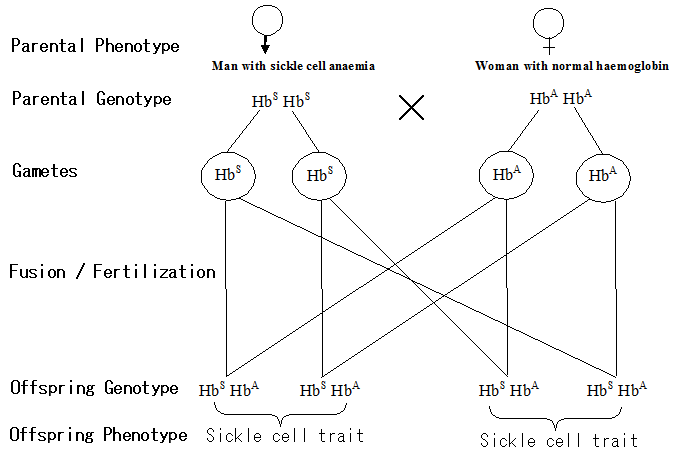INSTRUCTIONS TO CANDIDATES
- This paper consists of two sections. Section A and section B.
- Answer ALL questions in section A. In section B answer question 6 (compulsory) and either question 7 or 8
- The diagrams below shows samples of blood obtained from two different persons A and B.
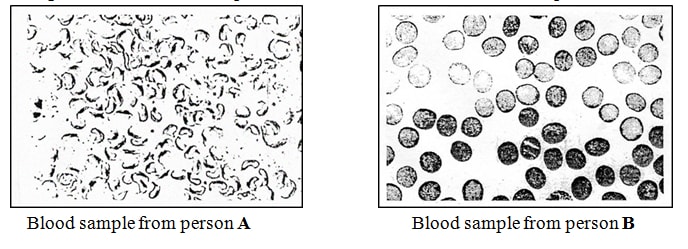
- What genetic disorder is person A suffering from? (1 mark)
- State one advantage and one disadvantage of the disorder in (a) above (2 marks)
- Work out the genotypes and phenotypes of the resulting offsprings of marriage between person A and person B (5 marks)
- The results in the table below show the effects of some conditions for seed germination. In each experiment, all other environmental conditions were kept constant, except for the one being investigated.
-
- What was the purpose of pyrogallic acid in experiment (P) (1mark)
- State the aim of the experiment (L) (1 mark)
-
- Account for the results obtained in experiment set-up (M). (3marks)
- State why 100% germination was not achieved in experiment (V) (L) (1mark)
- Of what biological significance is the condition necessary for germination being investigated by experiment (V). (2marks)
-
- The figure below is a photomicrograph of a section of mammalian skin. Study it and answer the questions that follow.
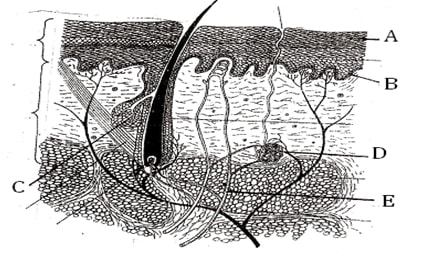
- Suggest why only one complete hair follicle is visible in the figure. (1mark)
- State two functions of the secretion from the gland labeled C (2marks)
- Indicate on the photograph by means of line labeled ‘K’ a muscle that contract to make hair become erect (mark)
- Name the parts labeled (3marks)
A …………………………………………….………………………………..…………………….
B .…………………………………………………………………….…………..…………………
D .....………………………………………………………………………………………………… - Explain the behaviour of structure E when environmental temperature falls to 100 (2marks)
- The epidermis of a leaf is adapted to have the specialized cells known as the guard cell such as shown below.
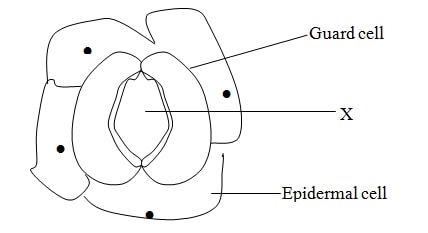
-
- Name the structure labelled X on the diagram. (1 mark)
- State three adaptations of the guard cell to its function of opening and closing of stomata in plants. (3 marks)
- The mammalian lung is known to have adapted the mammal to terrestrial habitat by having a pleural membrane.
- State two functions of a pleural membrane that gives the mammal advantage over other organisms. (2 marks)
- Name two diseases of the respiratory system. (2 marks)
-
- The question below represents a chemical equation that takes place in green plants under certain conditions
Carbon (IV) Oxide + water → Glucose + X- Name substance X (1mark)
- Other than the conditions stated in the equation, state two other conditions necessary for the reaction (2mks)
- Name two types of cells in which this process occurs (2mks)
- Name the process represented by the equation given above (1mk
- State the importance of the process named in (e) above (2mks)
SECTION B (40 MARKS)
Answer question 6 (compulsory) and either7 or 8 in spaces provided after questions 8.
- In an experiment to determine the effect of ringing on the concentration of sugar in phloem, a ring of bark from stem of a tree was cut and removed. The amount of sugar in grammes per 16cm3 piece of bark above the ring was measured over 24hour period. Sugar was also measured in the bark of a similar stem of a tree which was not ringed. The results are as shown in the table below.
- Using the same axis, plot a graph of sugar against time. (6 marks)
- At what time was the amount of sugar highest in the:
- Ringed stem......................................................................(1 mark)
- Normal stem......................................................................(1 mark)
-
- How much sugar would be in the ringed stem if it was measured at 0345 hours?(1 mark)
- Give reasons why there was sugar in the stems of both trees at 0645 hours. (2 marks)
- Account for the shape of the graph for the tree with ringed stem between:
- 0645 hours and 1545 hours. (3 marks)
- 1545 hours and 0045 hours. (2 marks)
- Name the structures in the phloem that are involved in the translocation of sugars. (2 marks)
- Other than sugars, name two compounds that are translocated in the phloem. (2 marks)
-
- State the causes of air pollution (5marks)
- Describe how air pollutants affect organisms hence state how air pollution can be alleviated (15mks)
- Describe how a bony fish like tilapia is adapted to locomotion in aquatic habitat. (20mks






MARKING SCHEME
Question 1
- Sickle cell anaemia
-
- A person can’t be attacked by malaria parasites/ can’t suffer from malaria
- - Periodic painful attacks characteristic of anaemia such as fatigue, shortness of breath, delayed growth and rapid heartbeat.
- Damage of internal organs such as the kidney, heart and joints
In severe cases early death from the kidney failure and respiratory failure or stroke is common.
(mark one)
-
Question 2
-
- Absorb oxygen
- To find out if light is necessary for germination
-
- - At 40C temperatures below optimum; enzymes are inactive hence little germination
- At 600C high temperature above optimum denatures enzymes / killed cells / protoplasm hence no germination
- At 350C optimum temperature / (w.t.t.e) hence highest % of germination. - Some seeds not viable
- - At 40C temperatures below optimum; enzymes are inactive hence little germination
- Water
- Activates enzymes, hence allowing them hydrolyze food
- Medium of chemical reaction
- Softens hard impermeable testa
- transport dissolved food to the developing parts of the embryo
Question 3
- Due to high magnification
- Makes the skin and hair surface water proof
To protect the skin against infection by bacteria and viruses (it’s a mild antiseptic)
Makes the skin and hair soft and supple - Name the parts labeled A,B,D
- A- cornified layer
B- Malpighian layer
D- Sweat gland - The structure (blood vessel) constricts // contracts (vasoconstricts) and lies deeper in the skin so as to reduce heat loss from the body through radiation
Question 4
-
- Stoma Rej. Stomata
- The walls of the guard cell is differentially thickened with thick inner membrane and thin outer membrane to open the stoma when turgid.
Numerous chloroplasts for photosynthesis which creates sugar for high osmotic gradient of the cell which draws in water from adjacent cells.
Bean and sausage shaped to create a pore/aperture/stoma for gaseous exchange. - During day time. The chloroplasts in the guard cell traps light for photosynthesis; which results into sugar that is a osmotically active; the sugars draw in water by osmosis; from adjacent epidermal cells making it turgid and opening stomata/converse is correct.
-
- Secretes pleural fluids
Holds the lungs in pleural cavity
Protection of lungs - Lung cancer
Asthma
Bronchitis (mark 1st two)
- Secretes pleural fluids
Question 5
- Oxygen
- Chlorophyl
Temperature
Light intensity (mark 1st two) - Guard cells
Palisade cells - Photosynthesis
- Production of food for plants and animals
Air purification
Release of oxygen in the atmosphere
Basis of source of energy (mark 1st two)
Question 6
-
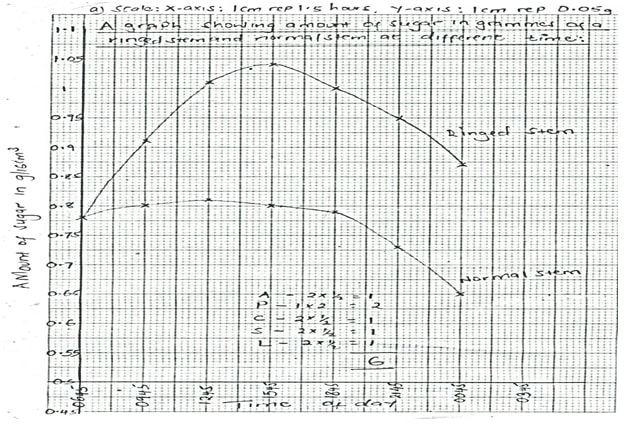
-
- 1545hrs
- 1245hrs
- 825 +0.02 grammes Acc. 0.81 (gm/16 cm3)
- The food that had been manufactured the previous day had been converted to soluble sugars and was being translocated to other parts of the plant; stored sugar; photosynthesis has started taking place
-
- 0645 hours and 1545 hours
There was low concentration of sugars early in the morning as there was little translocation; since the rate of photosynthesis is low due to low light intensity;
As the day progresses the light intensity increases; and more food is manufactured thus more translocation increasing concentration of sugars; Rapid / fast increase in sugar level due to photosynthesis and accumulation of sugar above the ring - The light intensity is decreasing thus reducing the rate of photosynthesis less food is manufactured hence less food being translocated; decrease in sugar level due to respiration As it turns dark there is no photosynthesis reducing concentration of sugars translocated;
- 0645 hours and 1545 hours
- - Sieve tubes
- cytoplasmic filaments/ strands
- Sieve elements - Amino acids
Soluble fats / lipids
Resins
Hormones;
Vitamins (Mark the first two)
Question 7
- Causes of air pollution
- Sulphur (IV) oxide, hydrogen sulphide and oxides of nitrogen from industries and emissions of exhaust fumes from motor vehicles;
- Carbon (IV) oxide from combustion of organic fuels;
- Carbon (II) oxide (CO) from incomplete combustion of fuels in industries and motor vehicles;
- Dust and smoke from quarries and factories;
- Radioactive radiations from atomic and nuclear plants;
- Agricultural chemicals used as sprays;
- Noise from factories and vehicles;
- Effects on organisms
- Sulphur (IV) oxide, nitrogen (IV) oxide, dust, smoke and carbon (iv) oxide cause respiratory diseases e.g. bronchitis and irritate the respiratory system;
- Nitrogen (IV) oxide and sulphur (IV) oxide combine with atmospheric moisture to form acid rain which is corrosive, poisons plants, lowers metabolic activities/photosynthesis;
- Dust and smoke reduce the amount of light reaching the plant lowering photosynthesis;
- Combines with vapour to form fog which reduce visibility and rate of photosynthesis;
- Carbon (II) oxide is a respiratory poison – it combines with haemoglobin reducing oxygen carrying capacity of red blood cells;
- Carbon (IV) oxide cause the green house effect that lead to global warming/change in climatic pattern;
- Radioactive radiations cause mutations and cancer;
- Some aerosols release chlorofluorocarbons that lead to depletion of the ozone layer leading to increased penetration of ultra radiations;
- Noise is irritant and cause stress in animals/it affects hearing in animals;
- Methods of alleviating
- Erect factories and power generating stations away from residential areas;
- Build factories with chimneys to discharge waste gases up above the ground;
- Government should enforce the legislative act on environment pollution;
- Encourage the use of lead free fuels in motor vehicles;
- Use alternative less polluting fuels, hydroelectric power, solar and wind energy;
- Educate people on dangers of air pollution;
- People working in factories and jua kali that generate loud noises should wear ear muffs;
Question 8
- It has a streamlined body√ – this reduces resistance√ against movement and enables it to cut through water easily
- It has inflexible√ head – this enables it to have forward thrust √
- The scales over lap√ and are pointed backwards to allow water to pass over √easily without any obstructions/resistance
- The fish secretes mucus√ – it reduces friction√ during movement
- It has flexible back bone with segments of muscle blocks√ –(mytomes) muscles contract and relax bring √about undulating movements
- Some fish have swim bladder between the vertebral column and the gut it provides the fish with buoyancy√ and to adjust its vertical position in relation to depth of water
- They have lateral√ line – this enables them to detect vibrations√ and changes of pressure in water enabling to respond suitability
- They have fins √which help them to move in water √
- Paired fins √– used for maintenance of balance, braking √and changing direction
- Unpaired fins - prevent yawing and rolling
- The fish body is laterally√ flattened to increase verified√ surface area of the body therefore preventing yawing and rolling
Download BIOLOGY PAPER 2 - 2020 KCSE PREDICTION SET 1 (QUESTIONS AND ANSWERS).
Tap Here to Download for 50/-
Get on WhatsApp for 50/-
Why download?
- ✔ To read offline at any time.
- ✔ To Print at your convenience
- ✔ Share Easily with Friends / Students

